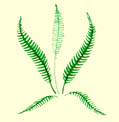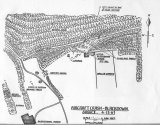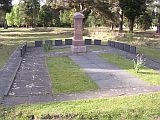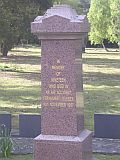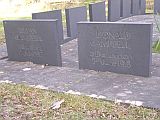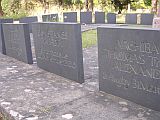The Fernhurst Society
Blackdown air crash
On the 50th anniversary of this air disaster, on Sat/Sun 4-5 Nov 2017 the Society organised a major exhibition and memorial service to commemorate the 1967 crash of the Iberia Airlines Caravelle into the slopes of Blackdown. More details.
Do you have more information? Can you help? Many people in Fernhurst (and Haslemere) heard or witnessed the disaster. Some even helped the emergency services. We'd like to include your personal memories of that fateful event in the Fernhurst Archives. So please do contact the Archives.
In November 1967 a passenger jet bound for London's Heathrow airport crashed into the southern slopes of Blackdown Hill, near to Fernhurst village, resulting in the tragic death of all 37 persons on board. The accident is recorded as the 11th worst air accident in the United Kingdom.
As the Society still frequently receives enquiries about the disaster, further details are provided below.
The police report from 1967 gives a harrowing account of the event:
"About 10.02 p.m. on Saturday, 4th November, 1967, a Caravelle Airliner No. EC-BDD, owned by Iberia Airlines of Spain, crashed at Black Down Hill, Sussex (map reference 919289). This Hill at its highest point is 902 ft. above sea level. The aircraft was on a scheduled flight from Malaga, Spain, to Heathrow Airport, and was piloted by Captain Harnando Maura [Pieres], 37 years, an experienced Pilot. It left Malaga at 7.30 p.m. G.M.T. and the estimated time of arrival at Heathrow Airport was 10.10 p.m. G.M.T. The weather at the time was slightly misty with intermittent drizzle but there was reasonable visibility."
The plane, a Sud Aviation Caravelle SE210, named Jesus Gurudi after the Basque composer, was travelling in a north-easterly direction. It initially struck trees in the grounds of Black Down House, then continued for hundreds of yards, "passing across a meadow where it killed 65 grazing sheep and injured 23 more which were subsequently destroyed". It then broke through a large hedge and parts of the aircraft fell off destroying a garage, and damaging parts of the roof of Upper Black Down House as the aircraft disintegrated.
Haslemere Fire Brigade were alerted within minutes of the crash, and were later joined by firemen from Grayshott, Liphook and Guildford. Aviation fuel had caused small fires to break out in the densely wooded hillside. It soon became clear however that all those on the flight had been killed on impact. "Debris from the aircraft was scattered over the whole of the 355 yards of its passage. There were no survivors from a total complement of 30 passengers and 7 crew". Fernhurst villagers provided essential support: the Village Hall was turned into a temporary mortuary and the WVRS (Women's Royal Voluntary Service) helped provide food and drink for the emergency services from the Youth Club behind the Spread Eagle public house.
Drawing from the police report showing the path of the accident (click for larger image) British Pathé newsreel video clip from 9 November 1967 The victims on the scheduled flight, Iberia 062, were the all-Spanish crew, and the passengers comprising 25 British, mostly returning from holiday in Spain, 2 Americans, 2 Spaniards and 2 Australians. Among the passengers were: the British film and TV actress June Thorburn, who was five months pregnant; industrialist and Coventry City Football Club vice-president John Clarkson; and Donald Campbell of the Campbell Aircraft Company. There is a memorial stone in Brookwood Cemetery, Surrey, honouring 19 of the deceased, as shown below.
Reasons for the crash? The plane's Black Box flight recorder was recovered from the scene, although the cockpit and instruments were badly damaged, making the investigation into the cause of the crash difficult. The aircraft appeared to be flying along its correct path, but at a significantly lower altitude. It is possible that the type of altimeters then in use were mis-read by the crew. It is suggested that the air navigation beacon at Northchapel was introduced as a result of the disaster to try to prevent it happening again (although navigation beacons provide position, not height, information to pilots).
images from Brookwood Cemetery (click for larger image)
|
Rosemary O'Gorman writes (November 2009): |
|
I remember the moment only too well as an 11-year old living the Shottermill side of Haslemere. The night it happened I was in bed and I remember hearing the sound of the engine overhead. It sounded louder than normal, very noisy. I lay awake listening to it. Then suddenly the sound stopped. I remember calling to my parents and saying that something had happened to the plane. They told me not to be so silly and to go back to bed. Later the next day we heard there had been a plane crash, and I knew then that that was the plane I heard. A few weeks later we went for a walk on Blackdown hill and I saw for the first time how it had gouged the ground. But I am still surprised to hear that the mystery of it has never really been solved. |
Sources:
- Aviation Safety Network Aircraft accident Sud Aviation SE-210 Caravelle 10R EC-BDD Black Down Hill
- Fernhurst Archives: press cuttings and reports
- Sussex Constabulary (1967). Report on Air Disaster at Blackdown Hill, Sussex, 4 November 1967 [by] Supt G. Dinley [West Sussex Record Office]
- Ewan Partridge "Fernhurst Remembered". Aviation News, September 2005, pp. 691-693
- "The Night Blackdown Claimed Flight IB06" The Haslemere Herald, 14 November 1977
- Find a Grave memorial in Brookwood Cemetary
- "Caravelle 10,000 ft too low" Flight International 9 November 1967
- Iberia Airlines Flight 062 Wikipedia entry
- "Donald Campbell" Flight International 9 November 1967
- "Caravelle Crash Report" Flight International 20 August 1970
- The working life of the Surrey Constabulary, 1851-1992 (2011). The Open University / Robert Bartlett (includes original interview transcripts with police officers who attended the crash site in 1967, and text copied, with credit, from this webpage)
© The Fernhurst Society
The Fernhurst Archives
Fernhurst History
